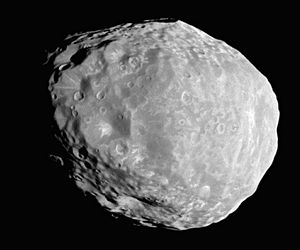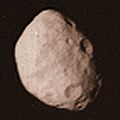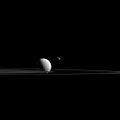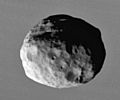Janus (moon) facts for kids
|
Janus as imaged by Cassini on April 7, 2010: highest-resolution full-disk image to date
|
|
| Discovery | |
|---|---|
| Discovered by | Audouin Dollfus |
| Discovery date | 15 December 1966 |
| Designations | |
|
Named after
|
Janus |
| Adjectives | Janian |
Janus is a small moon that goes around the planet Saturn. A scientist named Audouin Dollfus found it in 1966.
For a while, people thought Janus was the same moon as another one called Epimetheus. But in 1980, the Voyager 1 spacecraft showed that Saturn actually has two moons sharing almost the same path around the planet.
What's in a Name?
Janus got its name from a Roman god who had two faces. This god was also called Janus.
Even though the name was suggested in 1966, it wasn't officially used until 1983. That's when Epimetheus also got its official name. Janus is sometimes called Saturn X too.
What Janus Looks Like
Janus has many craters on its surface. Some of these craters are bigger than 30 kilometers (about 18 miles) wide!
Scientists think Janus's surface is older than the moon Prometheus, but younger than Pandora.
Janus is not very dense, which means it's quite light for its size. It also has a high albedo, meaning it reflects a lot of sunlight. This suggests that Janus is mostly made of ice and is very porous, like a "rubble pile" of icy pieces.
Images for kids
-
Epimetheus (lower left) and Janus (right) seen on 20 March 2006, two months after swapping orbits. The two moons appear close only because of foreshortening; in reality, Janus is about 40,000 km farther from Cassini than Epimetheus.
-
Janus as viewed by Voyager 2 (1981-08-25).
-
Janus and Prometheus lie above and below Saturn's rings (2006-04-29).
-
Janus and Tethys (foreground) near Saturn's rings (2015-10-27).
See also
 In Spanish: Jano (satélite) para niños
In Spanish: Jano (satélite) para niños









